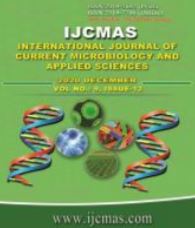


 National Academy of Agricultural Sciences (NAAS)
National Academy of Agricultural Sciences (NAAS)

|
PRINT ISSN : 2319-7692
Online ISSN : 2319-7706 Issues : 12 per year Publisher : Excellent Publishers Email : editorijcmas@gmail.com / submit@ijcmas.com Editor-in-chief: Dr.M.Prakash Index Copernicus ICV 2018: 95.39 NAAS RATING 2020: 5.38 |
During the investigation sucking pest viz; white fly and jassid were appeared in 33 standard meteorological week and maximum population of whitefly (0.60 per plant) and jassid (0.40 per plant) was recorded in 37th SMW. Correlation with sucking pest (whitefly and jassid) population and meteorological parameters was found positive non significant association with evening relative humidity and minimum temperature but negative correlation with maximum temperature, morning relative humidity and rainfall. The highest capsule borer population (45.33 /plant) was noticed in 37th SMW and maximum damaged capsule (67.69%) was observed in the 40th standard week. Correlation of capsule borer population exhibited non-significant and positive with relative humidity evening and temperature minimum, while, it was found negative with maximum temperature, morning relative humidity and rainy days. Til Hawk moth appeared in the 34th standard week and continued till the harvesting. The maximum til hawk moth (0.38 larvae per plant) was recorded at 36th SMW. Til hawk moth population was positively associated with rainy days, relative evening humidity, morning relative humidity and temperature minimum. However, it exhibited negative association with temperature maximum. The Gall fly was appeared on sesame in the 37th standard week and remained active on the crop up to 45th standard week. Maximum population was found in 40th standard weeks. However, the highest damaged capsule (59.31%) was observed in the 43th standard week.
 |
 |
 |
 |
 |